- About Us
- Columns
- Letters
- Cartoons
- The Udder Limits
- Archives
- Ezy Reading Archive
- 2024 Cud Archives
- 2023 Cud Archives
- 2022 Cud Archives
- 2021 Cud Archives
- 2020 Cud Archives
- 2015-2019
- 2010-2014
- 2004-2009
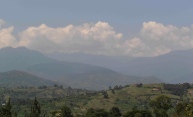 |
March 2012 - Postcard From Africa: |
Since the maps of the ancient Greeks, the ‘Mountains of the Moon’ have been marked –somewhere – in the centre of Africa, with the famous Alexandrian cartographer Ptolemy even recording them as the source of the Nile. It was only some millennia later, in July 1862 that John Hanning Speke disproved this theory, tracing the Nile to its major source at Lake Victoria (Ptolemy was close). However, the fabled Mountains of the Moon regained their mystique when they were ‘re-discovered’ a further 25 years later, by another Victorian adventurer – Henry Morton Stanley, who was better know for having ‘re-discovered’ Dr Livingstone (I presume) in 1871.
Stanley’s Mountains of the Moon (which were also Ptolemy’s, or so he presumed again) were the snow-capped Rwenzori Mountains, which rise well over 4000m and form Africa’s highest range (as opposed to higher free-standing volcanic peaks elsewhere on the continent). The icy heights, amid equatorial African jungle still recall Stanley and his fellow adventurers with the eponymous peaks – Baker (4843m), Speke (4890m) and Stanley (5109m). The Rwenzoris are the northern end of the Albertine Rift Mountain Range, marking the central watershed of Africa, separating the Nile and East African Rift Valley on one side, and the Congo Basin draining to the Atlantic on the other.
As Ptolemy had speculated, these fabled mountains form the backbone of sub-Saharan Africa – the modern day borders of Uganda, Rwanda and the Congo (some of the more logical African borders than many of the other arbitrary colonial lines drawn elsewhere on the continent), and it was this ominous, mist-covered heart that drew us to Kigali on Christmas Day 2011.

Don Cheadle managing the Hotel des Mille Collines
Rwanda, the Land of a Thousand Hills was plunged into the darkness of genocidal bloodshed in 1994, when up to a million Tutsis were killed by the Hutu majority in less than three months. The Hotel des Mille Collines (thousand hills) was immortalised in the 2004 movie Hotel Rwanda as it had served as an uneasy sanctuary from the civil war. As the poets of my adolescence – the rock band Guns and Roses – once asked: “What’s so civil about war anyway?” Certainly not the 250,000 un-marked graves at Kigali’s Genocide Memorial, nor the living conditions for over a thousand Tutsis seeking refuge in the hotel during the war. In contrast, the very same hotel was now a ‘Paradise City,’ where we had Christmas dinner overlooking Kigali from the rooftop restaurant, having swum and drunk cocktails by the hotel pool that afternoon.

Poolside at Hotel Rwanda 18 years later
The revival of the Hotel des Milles Collines in 18 years is mirrored by the remarkable changes that have happened throughout Rwanda. The autocratic president Paul Kagame led the besieged Tutsis back to power, and the redevelopment and reconciliation in the past two decades have been an amazing social experiment – and not just the banning of plastic bags throughout the country and expulsion of the French (both of which many other, more developed countries would also probably benefit from). Hutu and Tutsi, perpetrator and victim, soldiers and civilians all live together in one of Africa’s smallest but most prosperous and best organised countries. Not without reminders of the past however – the missing limbs, the scars, the memorials and perhaps more unsettling than the obviously physical relics, the long, guarded pauses before returning a smile or greeting.
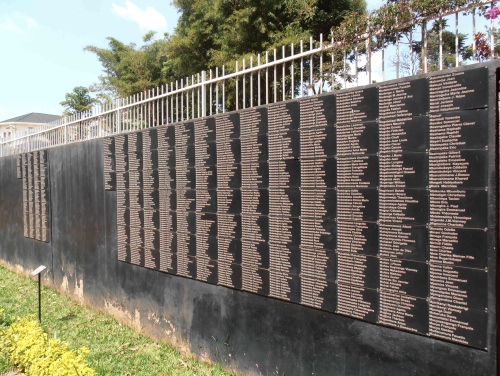
Names still be engraved at the Kigali Genocide Memorial
Perhaps exemplifying and indeed mirroring Rwanda’s prosperous progress since disaster, is plight of the Eastern Mountain Gorilla. The volcanic Virunga Mountains are the southern end of the Albertine Rift Mountain Range, home to the Parc National des Volcans and some of the last remaining Eastern Mountain Gorillas – which despite being almost driven to extinction are gradually increasing in number (hopefully aided by the USD500 per day permit to hike in the national park to see them).
We spent three hours clambering up muddy volcanic slopes behind a local guide, before he managed to locate the gorilla spotters (who’d been sent off some hours earlier), who had in turn managed to locate the gorillas. Apparently our family of 12 gorillas – a silverback named ‘Lucky,’ his various wives and children had been on the move this morning, which perhaps explained why they hardly stirred when a group of 8 tourists arrived to watch them for an hour – as groups have done every day for the past few years since the National Park re-opened. The remarkable primates reclined in their misty home, the younger ones tumbled, playing with each other, while the older ones grazed or just played with themselves (the silverback’s size belying the dexterity of his hands … and feet in that activity).
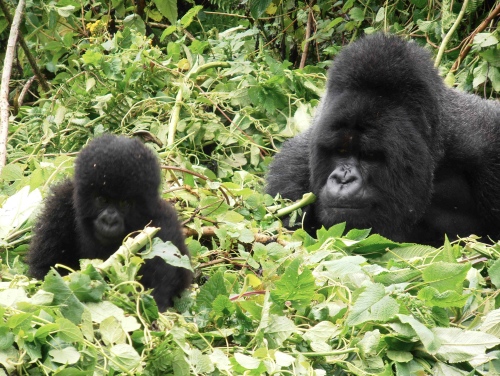
‘Lucky’ the silverback with the next generation of gorillas in the mist
An hour passed and we were shuffled down the hill again, slip-sliding away from Lucky and his family, who waited nonchalantly for the next group of homosapiens to arrive the next day. Before the next band of raincoat clad, camera wielding tourists turned up, they would presumably eat, play, reproduce and recline (in something like that order), as their total numbers have grown back towards the thousand mark in recent years – though still on the critically endangered list.
Meanwhile, we rumbled on towards Lake Kivu, Rwanda’s western border and the remarkably prosperous town of Gisenyi, with Mediterranean style villas and a history of relative luxury (and Hutu refuge as they retreated after the Tutsi tide turned against them). Following the lake north from the lush Rwandan frontier we reached the Congo border – Joseph Conrad’s ‘Heart of Darkness’, also the scene of Henry Morton Stanley’s darkened explorations for the marauding King Leopold of Belgium.
Far from looking for Kurtz, or rubber to exploit, we merely wanted to enter the Congo to see the centre of the earth, as after half a day’s climb up Mount Nyiragongo, you can peer into the largest lava lake in the world (2km across), in the heart of its crater. Sadly though, African bureaucracy and extortionate ‘prices’ meant that the passport remains without a stamp from the Congo, and Nyiragongo bubbles away unclimbed … awaiting its next fiery eruption.
Completing the trail along the Albertine Rift Mountain Range, we headed north into Uganda, also completing the celluloid tour – first Hotel Rwanda, then Gorillas in the Mist and now The Last King of Scotland. Fittingly we stumbled across the Last King of Kisoro (a small highland town in southern Uganda) – a massive, charming guide named Sheba, who looked uncannily like Forest Whitaker, when Forest Whitaker looked uncannily like Idi Amin … .
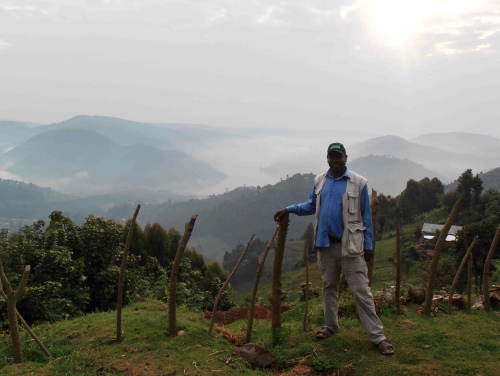
Sheba – the Last King of Kisoro
Mindful of categorising a country’s people on the basis of one character, Sheba did Uganda a very great service, and where guarded manners characterised Rwanda, Uganda burst with enthusiasm and joy – or Sheba did anyway (never more so than when accidentally driving us into a military installation on the shores of Lake Edward, chasing warthog.) Certainly no hint of Kony to be seen – but we didn’t have an internet connection – so that’s understandable … .
Crossing the equator, we bumbled our way along the foothills of the Rwenzori, joining the traffic of Landcruisers heavily laden with international aid workers and bicycles heavily laden with whole families and bananas – in the hundreds. Surprisingly the bicycle had been Winston Churchill’s choice of transport back in 1900 when he travelled through the former colony, and became so enamoured by Uganda’s natural resources wealth. In contrast, we dropped down out of the lush green hills of Uganda by bone rattling, over-crowded bus to Kampala, and after a day in the congested chaos sought the cleansing waters of Lake Victoria instead.
Then in the modern day spirit of Stanley, Speke and others, I took to the White Nile in white water kayak (appropriately enough), just below the recently constructed Owen Falls Dam, where I spent the morning practising my eskimo roll and promptly failed to produce it when needed that afternoon - upturned on the first head-high standing wave of the paddle. So having paddled (and partly swum) the Nile downstream of Lake Victoria, we then sought the monument to Speke’s 1862 discovery, and appropriately enough couldn’t find it.
Perhaps it had been in the Mountains of the Moon after all.
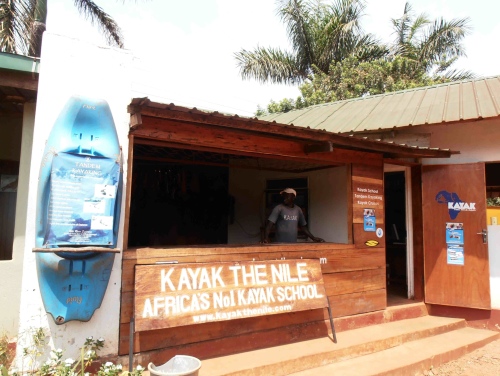
Paddling the White Nile
